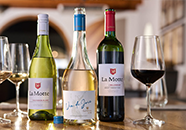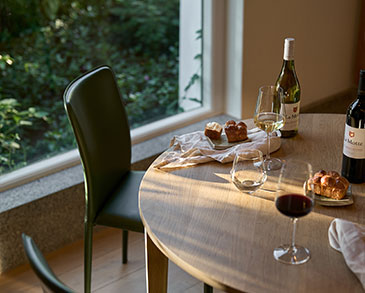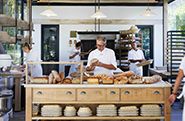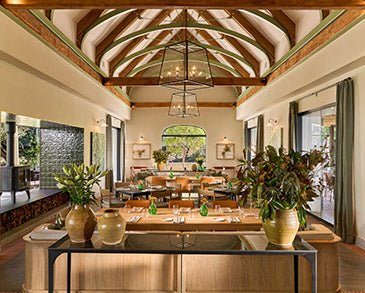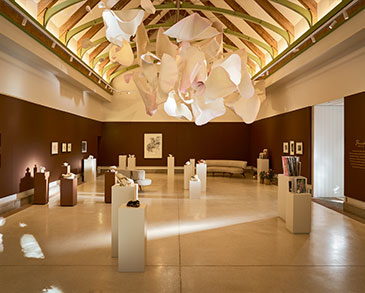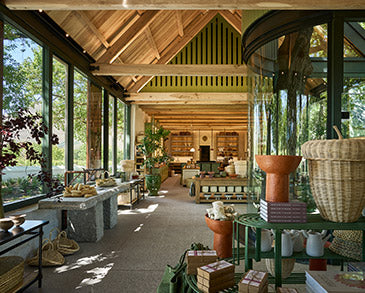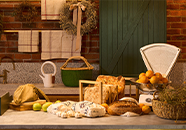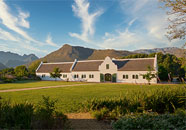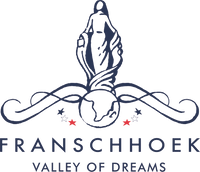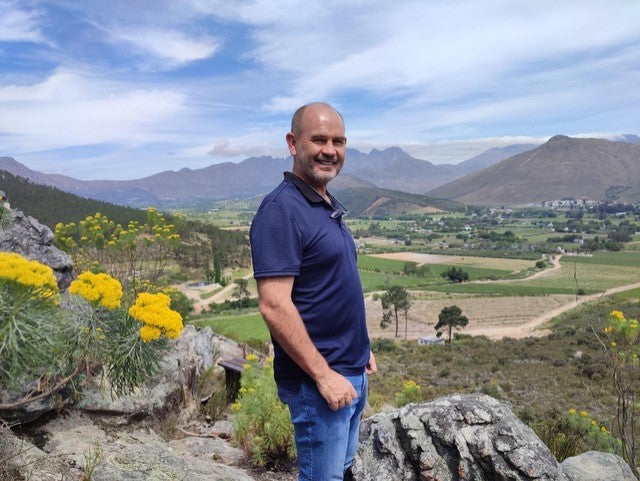
Kim Maxwell chatted to La Motte Cellarmaster Edmund Terblanche, who has been making wine at the estate for 24 years, about the terroir on the farm.
“We don’t have an Afrikaans or English word for it,” says Cellarmaster Edmund Terblanche, in reference to the French ‘terroir’ concept. It is the coming together of a few elements: vineyard soil, climate and environment, and giving a finished wine its distinctive character. The role played by the vineyard team is a factor too."
Let’s explore what makes La Motte’s terroir distinctive.
- 3 SHIRAZ WINES, 3 SOIL TYPES
Most Western Cape farms have soil types that are a mix of three mother blocks of SA terroir: Table Mountain sandstone, granite and shale soils. “On La Motte farm in Franschhoek, we have 90% sandstone, and a little bit of decomposed granite. Every farm has a soil type that dominates, and sometimes a mix of two or all three,” says Terblanche.
He makes his point, opening three different La Motte Shiraz wines from three soil mother blocks:
- La Motte Franschhoek Syrah 2018, with 100% Franschhoek grapes, grown on sandstone. The Franschhoek valley is sandstone and alluvial along riverbanks, but changes to yellowish-brown well-drained soils on higher lying mountain foothills. “The sandstone gives lighter-style wines with red fruit, creaminess and elegance.”
- La Motte Platinum Collection Shiraz 2022. The grapes are grown on Paarl granite soils on a farm in the vicinity of Paarl Rock. “We have mostly decomposed granite red and yellow soils on this Paarl property. Granite soils create body, richness and colour, but also tannin and intensity in red wines.” Plums and blackcurrants, bigger tannins. A bolder, richer, more intense wine with greater ageing potential.
- La Motte Pierneef Collection Syrah Viognier 2018. Grown on shale soils. “Shale soils have a tendency to incorporate minerality in a wine, where you almost feel like you put a river pebble in your mouth. There’s lots of freshness and finesse.” The grapes for this vintage came from shale soils in Elim, Napier and Walker Bay.
MOUNTAIN TERRAIN
Three mountains, Groot Drakenstein, Franschhoek and Wemmershoek, surround La Motte. “Our land goes halfway up the Wemmershoek mountain. The vineyards are as high as they can go. Above that it’s typical Boland mountain fynbos, which includes the Cape snowbush, buchu, proteas and other aromatic plants. That is definitely part of the terroir,” says Terblanche.
“La Motte is not a small farm – it’s approximately 160 hectares (ha). With about 70ha planted. At least a third is devoted to conservation and the protection of the natural fynbos,” says Terblanche. La Motte is a WWF conservation champion, meaning there’s a management plan to ensure that the natural environment, mostly found along the mountain section, is retained in a sustainable way.
La Motte Franschhoek Syrah is grown 100% on Franschhoek sandstone. “This wine is from one Syrah block ‘La Motte block 1’, sitting right up against the mountain at around 300m above sea level.
“If you talk vegetation terroir, it’s surrounded by pincushion proteas, king proteas and buchu. And if you talk animal terroir, the baboons take at least half our grapes.”
Block one is massively influenced by temperature. “There’s often mountain shade, thanks to the sun going down at about 4pm, and a cold surge of mountain air from higher up sweeping down into the vineyard. You can definitely taste a cooler climate element in this block.

“Syrah block ‘La Motte block 1’, sitting right up against the mountain at around 300m above sea level,” says Edmund Terblanche. “We had an even better block behind it, but the baboons took it all.”
“We pulled out an even better block just behind it, and planted proteas. The baboons took it all…” A third Shiraz block was lost thanks to September 2023 flood damage.
FYNBOS
Here’s something interesting. “As South Africans we don’t often mention fynbos in terroir, but it must have an influence on South African wine character,” says Terblanche.
“Australians have found that eucalyptus tree pollen actually sticks to the wax of the grape berries. They say if you have only two eucalyptus leaves in half a ton of red grapes while fermenting on their skins, you will have a noticeable eucalyptus taste in your wine. If that is true, then natural fynbos vegetation definitely has an influence on our South African grape flavours too.
“For our La Motte Franschhoek Syrah, the vineyards are as high as they can go. And then it’s typical Boland mountain fynbos growing above and around it, with includes the Cape snowbush, buchu and proteas.
“All definitely part of the terroir,” says Terblanche.
THE CLIMATE EFFECT
“In relation to other wine areas in the world, Franschhoek is sitting in a fairly warm section,” says Terblanche. “But in fact, we make very elegant white wines. The reason has to be the ‘air conditioning’ we have with the influence of the sea, it’s either north-west (mostly in winter) or south east (in summer). A south easterly wind sweeps down from the mountains.
“Wind, if strong, can be devastating or have a dwarfing effect on vines. Some varieties such as Chardonnay are sensitive to strong wind. But Franschhoek grows good Chardonnay as the wind isn’t that bad. We also adjust the direction in which our rows are planted to accommodate wind. Wind is necessary for its cooling effect, and for drying dew in the morning, so we don’t have fungal diseases on our vines. In this area we’re very blessed with a little wind every day, to dry out the vineyards – cool and dry is good.”
Chardonnay: “Chardonnay is one of the most consistent Franschhoek varieties. We make only 3,500 bottles of vintage MCC, mostly from Chardonnay (60% in most years). Plus a bit of Pinot Noir. The Chardonnay is 100% from La Motte. What we get in Chardonnay from Franschhoek is a creamy texture, with limey citrus character.
It’s planted on some of the best terroir in one of these kloofs, where the soils are richer, fuller. It originated from sandstone, with a higher percentage of darker yellow soils, where organic matter is mixed with mountain granite deposits.
La Motte Méthode Cap Classique uses Chardonnay and Pinot Noir grown exclusively on this Franschhoek property. The 2019 vintage is rich and beautiful, showing creaminess and fuller-bodied complexity after 46 months on its lease.
La Motte Chardonnay 2022 is a still wine, 100% from Chardonnay grapes, receiving 12 months maturation in mostly older barrels. It’s elegant and understated, nectarine, cashews and oatmeal. Says Terblanche: “It’s great that we can make two completely different styles from one supply of Chardonnay.”
Sauvignon Blanc: About 25% of the La Motte Sauvignon Blanc fruit comes from the Franschhoek farm. “La Motte’s popular Sauvignon Blanc started at La Motte and has always been about its drinkability. After a consumer switch to cooler-climate styles, Sauvignon has gone full circle and people again look for more tropical, creamier styles. It’s what this farm does well.
“Our better Franschhoek Sauvignon Blanc vineyards are to the left of the Wemmershoek hills. Tropical flavours, creamy texture, with a limey freshness – that shows in year one, when most of our Sauvignon Blanc wines are sold, contribute to its drinkability. Franschhoek is great at delivering that.
“Then 50% is Stellenbosch fruit, also tropical in style, but creating fuller, richer wines. And 25% is from Cape south coast vineyards in Elgin, Elim and Napier. These areas offer acidity and freshness. Together the Stellenbosch and Cape south coast grapes help with shelf life and complexity.
“Franschhoek is known for Semillon, and we always blend a little into our Sauvignon Blanc wine. One of our Semillon vineyards for La Motte Sauvignon Blanc is just below the manor house."
PIGGY BACKING ON NATURE
“We farmed fully organic for six years, but there was a shortage of phosphate in the soil as we couldn’t find a viable organic alternative to fertiliser. So we discontinued the organic status, but we learnt a lot about how to farm through the organic principles. Now we just call it biologic.”
“We all know the differences that a variety of terroirs can give you, but even on one La Motte property of approximately 160ha, you find a variety of different meso-climates, producing different results in small pockets. The shady kloof on La Motte is a good example.
“There’s the natural vegetation of different areas, the different mountains, the wind, the baboons playing a role. And the surge of cool air from higher areas rushing down the mountain and vanishing into the valley… All the steeper La Motte vineyards experience that down-surge, but at different times of the day. There’s also a major river in the valley, and over the years, different sediments have built up, so even the sandstone soils are not exactly the same, creating different terroirs all on one property.”

